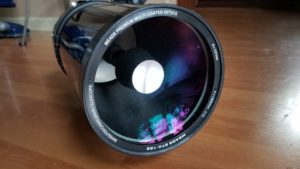By: Vlad Fedosov
Intro:
The ETX line of Meade scopes is without a doubt one of Meade’s most popular offerings because of their small size and built in GOTO functionality. While the entire ETX package certainly had its appeal, the optics on the “larger” units starting with the ETX-90 where the shining stars. Utilizing a Maksutov-Cassegrain design these scopes have optics that are sharp above what one would expect from an entry level line of scopes all in a very compact package. Let’s take a look at the EXT-125 OTA with UHTC coatings, the largest of the ETX line.

Testing:
I came across my EXT-125 OTA from a gentleman that was selling a working unit, and this one’s mount was used for parts. I have used the EXT mounts in the past including the ETX-80, ETX-90, and EXT-125 and did not find that the mount was the strong point of the unit. Simply put there is a bit much plastic involved leading to a less den sturdy mount. That’s why I was more than happy to rid this ETX-125 of this weakness and use the OTA on my Meade LXD-75 mount.
The OTA is well built when looking at it from the front end. As you move towards the rear you start to again run into the weakness of the EXT. The plastic. The rear housing that holds the eyepiece holder, flip mirror, and focuser is made of a plastic that is not horrible in quality but certainly makes the OTA feel cheap. The built in flip mirror is a cool option and allows you to use a standard diagonal 1.25” diagonal with the correct adapter(later I will explain why this is important) or attach a camera to the OTA. I have never had any issue with the flip mirrors operation but I do wonder how good of quality it is.

I used this OTA over several nights on top of my LXD-75 with rock solid results. This mount defiantly makes the ETX much more pleasurable to use compared to the stock mount. Using the ETX on a GEM mound did introduce a bit of a problem in that the stock built in diagonal placement in a lot of situations is pointed at weird angles and is difficult to observe with. This is where attaching a standard 1.25” diagonal that you then can rotate is a godsend. I found the focuser ok to use on the ETX. Nothing great, but nothing horrible as well. I do wish that the focus knob was a bit larger/longer. My unit did not have very much image shift.
The views through the ETX-125 where what you would expect from a Maksutov-Cassegrain. Pinpoint stars, with a well defined airy disk. At the time of observing I did not have any planets available to test the scope on but I know based on its double star performance that this scope would be a good planetary instrument. DSO performance was what you would expect from a 5”scope. Stars are a lot more refractor like then a standard SCT. The only downside I see to using this for DSO is that at f/15 and 1900mm focal length you are really limited in the FOV that you are able to attain(you really cannot use 2”eyepieces in this scope).
Conclusion:
So where does this scope fit into ones observing arsenal? Well that is a tough one for me. I did not end up keeping my unit as I found that everything that the ETX-125 can do my 4” APO can do as well or better with a quicker cool down. I think that if I did not have an APO in this aperture class then this would have been one hack of a quick look scope. Considering that one can be had for around $200, these 5” Maks are a real gem that I would not overlook for a quick look scope that is still capable as providing an image that will rival a 4” APO!
